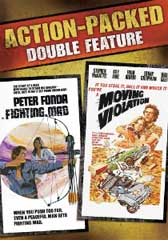 FIGHTING
MAD (1976)/MOVING VIOLATION (1976)
FIGHTING
MAD (1976)/MOVING VIOLATION (1976)Directors: Jonathan Demme/Charles S. Dubin
Shout Factory
 FIGHTING
MAD (1976)/MOVING VIOLATION (1976)
FIGHTING
MAD (1976)/MOVING VIOLATION (1976)“Peter Fonda is FIGHTING MAD” while Stephen McHattie and Kay Lenz are framed by the law in MOVING VIOLATION, two halves of a spectacular Shout! Factory action-packed DVD double feature.
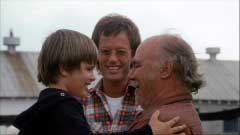
Widower Tom Hunter (Peter Fonda, DIRTY MARY CRAZY LARRY) returns to his Arkansas home town with his son Dylan (Gino Franco) only to find it beset by strip-mining company Crabtree Enterprises. Pierce Crabtree (Philip Carey, THE SCREAMING MIMI) has tried to buy farmland belonging to his father Jeff (John Doucette, BIG JAKE) and his brother Charlie (Scott Glenn, HEX). Charlie mentions that Crabtree’s men have even threatened his life. When Charlie and his wife meet a fiery end in their car at the bottom of a quarry, Tom is unable to convince the sheriff (Harry Northup, BOXCAR BERTHA) of Crabtree’s guilt. When Crabtree personally approaches his father about buying his land, Tom informs him that he has taken over his brother’s farm and his part in the civil action against Crabtree Enterprises (he also beats up Crabtree’s thugs). Shortly thereafter, a car attempts to run down Tom and his son on their motorcycle. Tom’s crusade against Crabtree alienates his recently resumed relationship with Lorene (Lynn Lowry, I DRINK YOUR BLOOD), who is planning to leave town after having to close down her family’s laundry business. Tom sneaks into the mining site and sabotages some of the equipment. When Crabtree’s men try to bulldoze a widow’s land, Tom physically intervenes and is arrested (along with his father, the widow, and some others) which means bad PR for Crabtree. When the courts rule that Crabtree Enterprises is not responsible for damage to surrounding property from their blasting, Crabtree uses that to his advantage to demolish the home of defiant Hal Fraser (Ted Markland, ONE FLEW OVER THE CUCKOOS NEST). When Fraser goes – Shotgun in hand – to the mining site and is shot in the back by Crabtree’s security consultant, Tom is fed up with the sheriff’s inaction (he also recognizes a tell-tale scar on one of Crabtree’s goons that suggests he had something to do with Charlie’s death). After his father perishes in a mysterious barn fire, Tom leaves his son with Lorene and dons his bow and arrow (and some firepower) to take on Crabtree and his goons in a final confrontation.
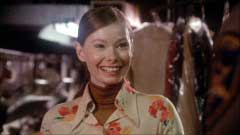 Although
Jonathan Demme (SOMETHING WILD) had already directed CAGED HEAT and ANGELS HARD
AS TEY COME for Corman, FIGHTING MAD was his first studio film (with Corman
producing for Twentieth Century Fox). It earns its R-rating with some bloody
(and meaty) violence, nudity and language (courtesy of Crabtree’s goons).
The script does not quite develop the hinted-at parallels between Tom’s
crusade to preserve the way of life he wants for his son – at the cost
of alienating those around him – and Crabtree’s burning more and
more bridges with powerful connections in order to prove that: “It’s
a free country, everything is for sale.” The film drags a little in the
middle section as it cuts back and forth between Tom and Crabtree separately
acting against each other. The sequence in which Tom sabotages some of the mining
equipment is mostly covered in an overhead shot by helicopter to better encompass
the action during a tight shoot. Although the soaring shots above the explosions
are nice, the lack of more detailed coverage does not milk much suspense from
Tom’s sneaking into the site and skulking around it.
Although
Jonathan Demme (SOMETHING WILD) had already directed CAGED HEAT and ANGELS HARD
AS TEY COME for Corman, FIGHTING MAD was his first studio film (with Corman
producing for Twentieth Century Fox). It earns its R-rating with some bloody
(and meaty) violence, nudity and language (courtesy of Crabtree’s goons).
The script does not quite develop the hinted-at parallels between Tom’s
crusade to preserve the way of life he wants for his son – at the cost
of alienating those around him – and Crabtree’s burning more and
more bridges with powerful connections in order to prove that: “It’s
a free country, everything is for sale.” The film drags a little in the
middle section as it cuts back and forth between Tom and Crabtree separately
acting against each other. The sequence in which Tom sabotages some of the mining
equipment is mostly covered in an overhead shot by helicopter to better encompass
the action during a tight shoot. Although the soaring shots above the explosions
are nice, the lack of more detailed coverage does not milk much suspense from
Tom’s sneaking into the site and skulking around it.

Fonda has presence as always, but his performance is a bit undermined by the scripting: Tom is right all the time, despite any misgivings his father and girlfriend have about his actions. Inexperienced Franco is good as Fonda’s son, although he’s mainly there for the potential of being in danger. Although he had a long career in film and television (including LAREDO and PHILLIP MARLOWE), the late Carey might have been most recognizable to some viewers for his 20-year stint on the soap ONE LIFE TO LIVE. He makes a suitably contemptible corporate villain and trades some humorous adlibs with Fonda during some tense confrontations. Lowry (in her first studio film) gets to kick some ass when Fonda is ambushed by thugs, but she is given little else to do. Her character breaks up with Tom early on in his crusade and just hangs around until the climax, but she is nevertheless a welcome presence who should have had a larger part. Glenn had previously co-starred in Demme’s ANGELS HARD AS THEY COME and, of course, would go on to co-star in SILENCE OF THE LAMBS (which also featured Northup). Demme also gets some good mileage out of the local color with the extras casting (as well as some University of Arkansas faculty). Stunt driver Al Wyatt’s father appears as the Washington judge ruling on the Crabtree lawsuit (during the production’s sojourn to D.C.). Cinematographer-turned-prolific-TV-director Mark Watkin (POINT OF NO RETURN) lenses the film beautifully with wide angle landscapes and farming tableaux, silhouettes against golden sunsets, and present is Corman’s penchant for foreground props to lend depth to shots as well as providing interesting backgrounds to stimulate the eye (Demme regular Tak Fujimoto [SILENCE OF THE LAMBS] shot some second unit work, but was sent packing back to California since he was not yet in the cinematographer’s guild).
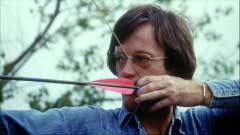 FIGHTING
MAD makes its digital debut here in a new anamorphic 1.78:1 transfer that seems
true to the film’s original cinematography. Well-exposed day scenes have
a healthy level of grain, while the more contrasty night scenes are a bit grainier.
There is little to no edge enhancement evident. The 2.0 mono audio is in good
condition (although some of the adlibs could have stood to be relooped). Corman,
Demme, and actors Fonda and Lowry are all recorded together on the audio commentary
track. Demme mentions that he wanted Charles Napier for the Crabtree role based
on his appearances in Russ Meyer’s films, but Corman felt the film need
a bigger name (at the time). He also mentions that he and composer Bruce Langhorne
(who scored Fonda’s THE HIRED HAND) listened to Ennio Morricone’s
score for ONCE UPON A TIME IN THE WEST for inspiration for the film’s
soundtrack. Demme tells Lowry that he cast her based on her sweet performance
in Radley Metzger’s SCORE. Fonda comes in at 19 minutes and remains for
the duration. Fonda mentions that the handguns used by him and Crabtree’s
bodyguard in the climax belonged to him. He is good-humored about Demme’s
anecdote that the only time the actor threw his weight around on the film was
in the selection of Langhorne as composer. Lowry mentions that Fonda did not
want her to slap him as scripted, but Demme told her to do it anyway. Corman
says the inspiration for the production was the success of so-called “hillbilly
revenge films” like BILLY JACK. He also describes his paternal feelings
for child actor Franco, whose father had been shot in a drugstore holdup a few
months before filming (and how he might react to the climactic scenes). The
group chuckle over how grateful they were that they did not have to do any retakes
of a shot of Fonda’s total destruction of an elaborate prop (of which
they had no duplicates). Fonda also cops to taking out one of the spot lights
with an arrow (it is not apparent on film since the rigged arrow in the subsequent
shot is supposed to hit the person holding the light). They also have fond memories
of Doucette and Carey, as well as Watkin’s daring attempts at ultimate
coverage during the barn-burning scene. The film’s theatrical trailer
and TV spot round out the extras for this half of the double bill.
FIGHTING
MAD makes its digital debut here in a new anamorphic 1.78:1 transfer that seems
true to the film’s original cinematography. Well-exposed day scenes have
a healthy level of grain, while the more contrasty night scenes are a bit grainier.
There is little to no edge enhancement evident. The 2.0 mono audio is in good
condition (although some of the adlibs could have stood to be relooped). Corman,
Demme, and actors Fonda and Lowry are all recorded together on the audio commentary
track. Demme mentions that he wanted Charles Napier for the Crabtree role based
on his appearances in Russ Meyer’s films, but Corman felt the film need
a bigger name (at the time). He also mentions that he and composer Bruce Langhorne
(who scored Fonda’s THE HIRED HAND) listened to Ennio Morricone’s
score for ONCE UPON A TIME IN THE WEST for inspiration for the film’s
soundtrack. Demme tells Lowry that he cast her based on her sweet performance
in Radley Metzger’s SCORE. Fonda comes in at 19 minutes and remains for
the duration. Fonda mentions that the handguns used by him and Crabtree’s
bodyguard in the climax belonged to him. He is good-humored about Demme’s
anecdote that the only time the actor threw his weight around on the film was
in the selection of Langhorne as composer. Lowry mentions that Fonda did not
want her to slap him as scripted, but Demme told her to do it anyway. Corman
says the inspiration for the production was the success of so-called “hillbilly
revenge films” like BILLY JACK. He also describes his paternal feelings
for child actor Franco, whose father had been shot in a drugstore holdup a few
months before filming (and how he might react to the climactic scenes). The
group chuckle over how grateful they were that they did not have to do any retakes
of a shot of Fonda’s total destruction of an elaborate prop (of which
they had no duplicates). Fonda also cops to taking out one of the spot lights
with an arrow (it is not apparent on film since the rigged arrow in the subsequent
shot is supposed to hit the person holding the light). They also have fond memories
of Doucette and Carey, as well as Watkin’s daring attempts at ultimate
coverage during the barn-burning scene. The film’s theatrical trailer
and TV spot round out the extras for this half of the double bill.
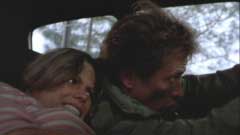
In MOVING VIOLATION, no sooner does hippie drifter Eddie (Stephen McHattie, PONTYPOOL) – “he’s a stranger in a foreign land, and the law don’t give a damn” croons Phil Everly in the theme song “Detroit Man” – set foot in the small town of Rockfield than he is set upon by Sheriff Rankin (Lonny Chapman, THE WITCH WHO CAME FROM THE SEA) and Deputy Tylor (Dennis Redfield, DEAD & BURIED). They knock him out and escort him to the other side of town. Local waitress Cam (Kay Lenz, HOUSE) proves friendlier, and the two sneak onto the estate of local bigwig H.R. Rockfield (Will Geer, THE MAFU CAGE) for a skinny-dip in his pool. Rockfield has the police department in his pocket, but Tylor wants more money and tries to extort it from the old man, whose family has been pumping oil from under city property. Cam and Eddie witness the Sheriff shooting Tylor. They run, but a wounded Tylor stumbles into the back of their van, resulting in the film’s first car chase. Cam and Eddie evade the sheriff and steal his car; of course, this does not help matters when they try to explain over the radio that they are innocent. The Sheriff places the blame for the cop’s death on them and soon has the town up in arms. When Cam and Eddie realize they have been set up for the murder, they realize they have to forget about getting to the police in the next town and get a lawyer instead. Cam is able to contact a federal agent (John S. Ragin, EARTHQUAKE); however, she only gets half the story out before she and Eddie have to go on the run again, but it is enough for the agent to start asking questions. They seek the help of laconic lawyer Alex Warren (Eddie Albert, THE DEVIL’S RAIN), who fortunately has it in for Rankin himself. Eager to silence them, the Sheriff shows increasingly less and less concern for public safety while trying to get to them, but he does not realize that Rockfield has spun a story about Cam and Eddie being radical terrorists (which includes the fatal wounding of the Sheriff as well). Warren uses his wits against Rockfield and Rankin.
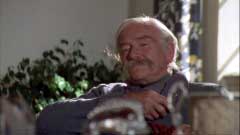 The
film is a series of excitingly-shot and edited car chases in a series of stolen
cars and dented cop cars – with the pursuers and the pursued encountering
a lot of human and automobile obstacles on the roads – broken up by foot
chases and occasional static bits of exposition. There are some impressive auto
and motorcycle stunts (including a car that loses its top as it sails under
a jackknifed trailer and a motorcycle cop who crashes into the back of a car,
and reportedly really broke his leg). There is a nice balance between the thriller
aspects and the comedic (mostly in the form of bumbling cops continually outsmarted
by the protagonists), and the final extended car chase is exciting and funny
(Corman regular Dick Miller shows up long enough to crash into an outhouse),
before a shocking shift in tone. The resolution seems rushed (despite more pyrotechnics),
and the bittersweet ending is not entirely satisfactory (in the commentary,
McHattie says he is not exactly sure how the movie got to that point from where
it started). Nevertheless, it is the more exciting of the double bill.
The
film is a series of excitingly-shot and edited car chases in a series of stolen
cars and dented cop cars – with the pursuers and the pursued encountering
a lot of human and automobile obstacles on the roads – broken up by foot
chases and occasional static bits of exposition. There are some impressive auto
and motorcycle stunts (including a car that loses its top as it sails under
a jackknifed trailer and a motorcycle cop who crashes into the back of a car,
and reportedly really broke his leg). There is a nice balance between the thriller
aspects and the comedic (mostly in the form of bumbling cops continually outsmarted
by the protagonists), and the final extended car chase is exciting and funny
(Corman regular Dick Miller shows up long enough to crash into an outhouse),
before a shocking shift in tone. The resolution seems rushed (despite more pyrotechnics),
and the bittersweet ending is not entirely satisfactory (in the commentary,
McHattie says he is not exactly sure how the movie got to that point from where
it started). Nevertheless, it is the more exciting of the double bill.

McHattie and Lenz are not given much time to establish their characters beyond drifter and bored local girl before they are thrown into the action. We root for them because Chapman is better as the villain. Geer is great in his supporting role, reacting to Tylor’s attempt at blackmail with: “Here I invite you to dinner, and you start off by stealing the silverware.” Albert does not appear until almost an hour into the film but, like Geer, he makes the most of his scenes. Ron Howard regular Paul Linke (GRAND THEFT AUTO) appears early on as one of the cops. Don Peake’s (PEOPLE UNDER THE STAIRS) score hits all of the common country car chase notes (heavy on the banjo and fiddle), but the aforementioned Everly theme song is the more notable aspect of the soundtrack. HUMANOIDS FROM THE DEEP director Barbara Peeters served as second unit director, shooting some of the car stunts and explosions not involving the main cast. Although made the same year as FIGHTING MAD, MOVING VIOLATION was rated PG despite Lenz’s topless scenes and some bloody bullet-hits.
 MOVING
VIOLATION also makes its digital debut here in a 16:9 1.78:1 anamorphic widescreen
transfer with good mono audio. MOVING VIOLATION is a sunnier film than FIGHTING
MAD, and as such, it looks cleaner overall (although that is because the cinematographer
is less adventurous in with regard to lighting than Watkin on the Fonda film).
Besides the trailer and TV spot, MOVING VIOLATION also sports an audio commentary
with producer Julie Corman, Dubin, and McHattie (Roger Corman was supposed to
participate but did not, although he is still mentioned on the cover art which
was printed beforehand). Dubin (recorded separate) is very complementary of
Julie Corman and observes that studio films are restrictive in terms of union
requirements while the budget can be equally restrictive on independent films.
Julie Corman mentions that she started out as a location scout and she enjoys
finding spots in Southern California that can stand in for other places (and
trying to avoid telltale palm trees and orange trees). She takes on the job
of moderating the commentary, by attempting to keep McHattie talking, but his
memories of the film are rather sporadic. She also mentions that their slow
motion footage of an airbag crash was shown to congress. Dubin mentions that
Albert did not enjoy having to participate in some of the dangerous stunt shots
during the climactic chase. Sometimes it is evident that Dubin is recorded separately,
but he is also able to fill in some blank spaces as if responding to Corman’s
prompting from the earlier recording. Unlike the FIGHTING MAD commentary, there
are a couple stretches of silence. Additionally, the disc features trailers
for DAMNATION ALLEY, RACE WITH THE DEVIL, GORDON’S WAR, and DIRTY MARY
CRAZY LARRY. (Eric
Cotenas)
MOVING
VIOLATION also makes its digital debut here in a 16:9 1.78:1 anamorphic widescreen
transfer with good mono audio. MOVING VIOLATION is a sunnier film than FIGHTING
MAD, and as such, it looks cleaner overall (although that is because the cinematographer
is less adventurous in with regard to lighting than Watkin on the Fonda film).
Besides the trailer and TV spot, MOVING VIOLATION also sports an audio commentary
with producer Julie Corman, Dubin, and McHattie (Roger Corman was supposed to
participate but did not, although he is still mentioned on the cover art which
was printed beforehand). Dubin (recorded separate) is very complementary of
Julie Corman and observes that studio films are restrictive in terms of union
requirements while the budget can be equally restrictive on independent films.
Julie Corman mentions that she started out as a location scout and she enjoys
finding spots in Southern California that can stand in for other places (and
trying to avoid telltale palm trees and orange trees). She takes on the job
of moderating the commentary, by attempting to keep McHattie talking, but his
memories of the film are rather sporadic. She also mentions that their slow
motion footage of an airbag crash was shown to congress. Dubin mentions that
Albert did not enjoy having to participate in some of the dangerous stunt shots
during the climactic chase. Sometimes it is evident that Dubin is recorded separately,
but he is also able to fill in some blank spaces as if responding to Corman’s
prompting from the earlier recording. Unlike the FIGHTING MAD commentary, there
are a couple stretches of silence. Additionally, the disc features trailers
for DAMNATION ALLEY, RACE WITH THE DEVIL, GORDON’S WAR, and DIRTY MARY
CRAZY LARRY. (Eric
Cotenas)